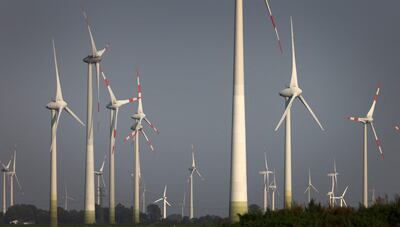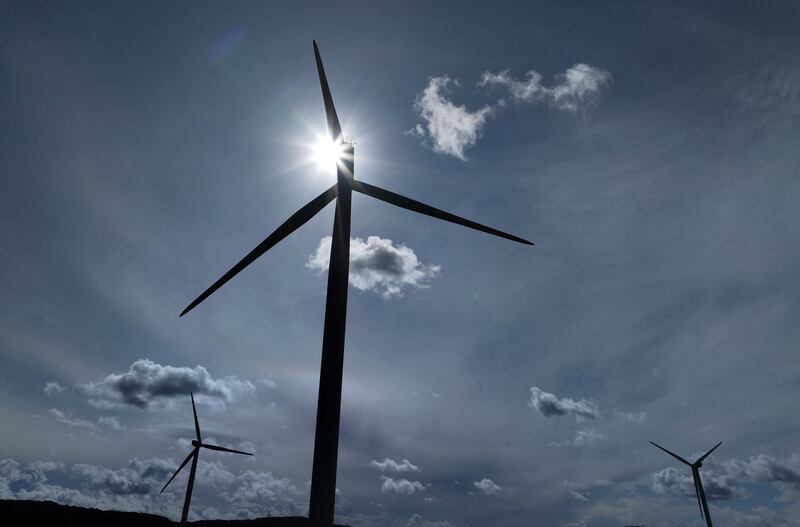A giant crane hoists a 40-tonne chunk of turbine tower almost 60 metres in the air and then places it on top of a half-finished structure. What’s different about this project is that it isn’t made from the usual ingredient: steel.
Rather, start-up Modvion is building the tower out of wood, a material it says will reduce the carbon footprint by more than 90 per cent. This will be the world’s tallest turbine of timber when completed in the coming weeks, and then it will be sold to a utility supplying clean energy to local homes and factories.
Sweden has a rich heritage of using wood in everything from windmills to centuries-old churches, clogs, decorative Dala horses and even a skyscraper.
Modvion is drawing on that craftsmanship to disrupt a forecasted $40 billion tower industry, where the use of heavily polluting steel and cement hasn’t changed much in the past few decades, undermining the turbines’ environmental benefits.
“The world is facing a climate crisis, and we need to switch energy sources,” chief executive Otto Lundman said after watching the lift. “Wind power is one of the most efficient and attractive that we have. We increase that value further.”
While the blades and the machinery are industry standard equipment, the approach has attracted interest from some of Europe’s biggest energy companies. Vestas Wind Systems bought 15 per cent of the firm after seeing a smaller demonstration model, and Italy’s Enel Green Power reached a co-operation agreement.
Sweden’s Vattenfall is a partner, and Germany’s RWE signed a letter of intent in March to use Modvion’s wooden towers in future projects.
The planet’s original building material is making a comeback in the net-zero age, with timber high-rises, corporate campuses and Olympic Village housing all in the works. A 20-storey “plyscraper” opened in Skelleftea, Sweden, in 2021.
Even as the wind industry is suffering from cost increases, supply chain bottlenecks and financing problems due to higher interest rates, forecasts for growth are still huge as nations rush to meet ambitious plans for reducing carbon dioxide emissions.
Annual European onshore installations are predicted to surge by almost a quarter by 2030, according to BloombergNEF.
Wind additions will exceed 16 gigawatts for the first time this year, with Germany, France, Spain, Sweden and Finland propping up the estimate.
“We expect our collaboration to increase,” said Todd O’Neill, chief executive of Vestas Ventures. “Many of our customers have proactively inquired to learn how they can be a part of Modvion’s journey.”
That connection comes in handy. The generator on top of the timber tower will be a recycled Vestas V90 2-megawatt machine. The Danish wind giant also will supply blades to crown the structure, which will be 150 metres (492 feet) tall when finished.
Modvion’s project outside Skara, Sweden, is made from Finnish spruce that’s laminated for strength and protection against the elements and fire, and then curved into four pieces about 30 centimetres thick. The tower walls may get thinner in the future as Modvion refines the technology.
The modules are stacked on lorries at a factory in Gothenburg and then glued together on site.

The assembly process saves on future maintenance costs since the typical steel tower contains as many as 50,000 bolts requiring manual checks by workers. Modvion’s towers can be inspected by sending up a drone instead.
Yet it’s the numbers surrounding carbon dioxide emissions – both in manufacturing and operation – that give wood a significant edge over steel.
Steelmaking is responsible for about 8 per cent of the energy industry’s CO2 emissions, and decarbonising will require trillions of dollars in investments. By comparison, wood is a carbon sink and renewable.
Parts of Modvion’s factory are automated, with robots sawing notches into the ends of the modules so they can be slotted together like a jigsaw puzzle. Still, there’s also some old style carpentry going on.
During a recent visit, workers used a measuring tape, nail gun and hand saw to get the pieces just right. To scale up in the future, even more of the work would probably need to be done with machines.
The laminated lumber is stronger than steel at the same weight, so wooden turbines can be taller and support bigger blades (generating more electricity) while needing less reinforcement (saving on building costs), the company says.
Lundman declined to say how much the machine with the timber tower will cost. A standard 2-megawatt turbine is about $2 million, said Leo Wang, a wind analyst at BloombergNEF.
Enel expects significant cost reductions from using wood once a supply chain and economies of scale have been established.
“We are currently monitoring their development so that we are ready to use the technology once it will be available for large-scale applications,’’ said Nicola Rossi, head of innovation at Enel Green Power.
“Wooden solutions are promising, but the long-term benefits of a full-scale adoption of wooden towers in a commercial wind farm are yet to be assessed.”
Modvion, which bills itself as a tech company focusing on engineered wood, is the brainchild of David Olivegren, 56, a carpenter, boat builder and architect.
He developed concepts for wooden masts and tubes during his studies, honed his skills while renovating old houses and even built a small wind turbine meant to charge a converted Renault car.
The start-up, founded in 2016, has received funding from the European Union and the Swedish Energy Agency. Earlier this year, 125 million Swedish kronor ($11 million) were raised through a convertible note issue.
A capital round of €20 million ($21 million), raised primarily through equity stakes, should close in the first quarter of 2024, according to the company.
That will helping financing a 150 metre tall tower, which will support a 6-megawatt machine ready to generate electricity in 2025.






